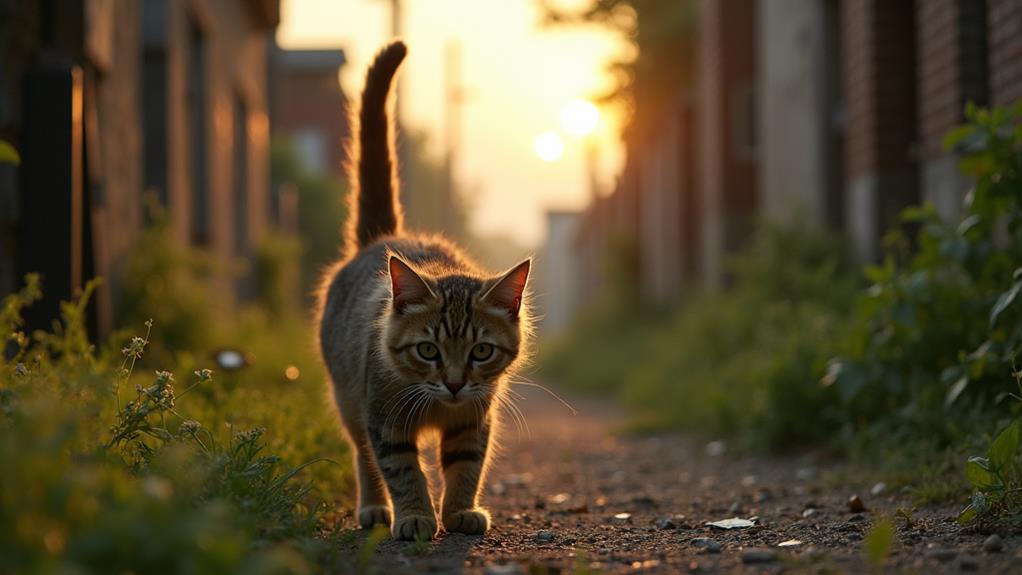How Long Does It Take a Feral Cat to Adjust to a New Home?

It generally takes 2 to 4 weeks for a feral cat to adjust to a new home. Start by creating a safe, quiet room with necessities like food, water, and a litter box. Daily interactions, like gentle talking and feeding, build trust and familiarity. Patience is key, as cats adapt at their own pace. You might notice comfort through playful behavior, relaxed lounging, or eating in your presence as signs of progress. Establishing a routine and avoiding forced contact will help the adjustment. If you're curious about fostering trust and ensuring a smooth acclimatization for your new feline friend, there's more to uncover.
Acclimation Timeline
Adjusting to a new environment can be an significant progression for feral cats, and understanding their acclimation timeline is critical. Typically, feral cats need an acclimation period of about 2 to 4 weeks to adjust to their new home. This period can vary, particularly if the cat has a more feral temperament, potentially requiring the full 4 weeks to truly settle in. During this time, it's imperative to observe their behavior closely.
You'll notice signs of readiness for release when feral cats start lounging, playing, and eating comfortably around you. These activities indicate they're becoming familiar with their new surroundings and are starting to feel secure. Your daily interactions play a key role in this process. By cleaning their cages and speaking to them regularly, you help them acclimate by getting used to your voice, which can be a comforting presence.
Initially, after the initial two weeks, pay close attention to their behavior. Are they showing signs of comfort or still skittish? This observation will guide your decisions on their release. Remember, patience is fundamental; each cat's acclimation is unique and may take time.
Creating a Safe Space
To help feral cats feel secure during their adjustment, setting up a designated safe space is crucial. Choose a quiet room where your feral cat can acclimate comfortably. Equip this area with vital supplies like scratching posts, toys, food, water, and a litter box. These items create a secure environment that helps ease the cat's change.
Position the food bowl and litter box on opposite sides of the room. This setup encourages comfort and reduces stress associated with being too close to waste. You want your feral friend to feel at ease as they investigate their new surroundings.
Include small hiding spots such as cat houses or draped blankets. These offer the cat safe retreats, important for acclimating to their new home. However, make sure these spots are accessible and not overly secluded. This balance allows the cat to feel secure while still engaging with their environment.
Spend time in the safe space daily. Your presence helps the cat become accustomed to humans, aiding in building trust over time. Patience and consistency in your approach will help the feral cat adjust, turning a new house into a comforting home.
Feeding Strategies

Once your feral cat has a safe space, it's time to establish feeding strategies that promote comfort and trust. Start by implementing a structured feeding schedule, ideally twice a day. This consistency helps your feral cat acclimate to its new environment. Use a specific summoning call or phrase during feeding times. This small routine encourages the cat to associate your presence with positive experiences, gradually building trust.
When setting out food, provide only enough for one sitting. This prevents attracting pests and guarantees the cat's safety in its new setting. Introducing appealing food options is essential, especially for feral kittens. Enticing treats can encourage them to investigate their surroundings, making them feel more at ease. Always keep in mind that food and water bowls should be placed in quiet, accessible areas to minimize stress. This positioning promotes regular eating habits, which are important for the cat's comfort.
As you go through this process, focus on patience and observation. Your feral cat might need time to adjust, but with consistent feeding strategies and a little patience, you'll create a nurturing environment where your cat can thrive.
Recognizing Comfort Signals
Recognizing comfort signals in feral cats is a vital aspect of understanding their acclimation to a new home. As these cats adjust, you'll notice them lounging in a relaxed position or stretching out in their crate after about 2-4 weeks. This behavior signals that they're starting to feel more at ease. When they engage in playful behavior, such as batting at toys or interacting with other cats, it's a strong indicator they're feeling secure.
You'll also observe them eating and drinking in your presence without signs of stress. This is a positive step towards their comfort with the new environment. Exploration is another important signal; when they venture out of hiding spots to sniff around and investigate their surroundings, it means they're ready for a more open living situation.
Pay close attention to their vocalizations. Meowing or purring when you're nearby indicates they're developing trust. These signs collectively confirm that your feral cat is adjusting well. By recognizing these comfort signals, you can better understand their progress and continue providing a supportive environment as they adapt into their new home.
Building Trust Gradually

When building trust with a feral cat, patience is key. You need to understand that the adjustment period can last anywhere from several weeks to months. Each cat has its own temperament and past experiences that shape how quickly it feels safe around humans. To foster trust, allow the cat to approach you at its own pace. Use food as a tool to create positive associations. Offering food from your hand or extending a closed fist encourages the cat to voluntarily interact with you.
Avoid forcing physical contact; doing so can hinder progress. Instead, focus on spending time in the same room without pressuring the cat to engage. This helps it feel more secure and familiar with your presence. Pay attention to the cat's body language to gauge its comfort level. Recognizing signs of stress or fear guarantees you're building trust at a pace that works for the cat.
Socialization Techniques
Although patience is vital, effective socialization techniques can greatly aid in acclimating feral cats to their new environment. To help the cat adjust, start by using stick toys to engage them in play. This activity not only helps expend their energy but also fosters trust over time. Remember, it's critical to let the kittens retreat when they feel threatened rather than chasing them. Gradual trust-building is key to successful socialization.
Consistent interaction is another significant technique. Spend time in the same room as the cat, even if you're just reading or working quietly. Your presence will help the cat grow accustomed to you, making them feel more secure. As you work to socialize the cats, positive reinforcement plays a major role. Offering treats during exploration encourages them to engage with their surroundings and builds their confidence.
Pay close attention to their body language. Recognizing signs of stress guarantees that your interactions remain effective and low-stress. By understanding these cues, you can adjust your approach accordingly, creating an environment conducive to the cat's comfort. These techniques, when practiced consistently, pave the way for a well-socialized cat that feels at home in its new setting.
Managing Stress Levels

Managing stress levels is fundamental when acclimating feral cats to a new environment. These community cats thrive when they're comfortable, so it's important to limit the number of new experiences introduced each day. By doing so, you prevent overwhelming them, allowing for gradual adjustment. Recognize signs of stress, such as hiding or flattened ears. If you notice these, make sure you provide a safe space where the cat can retreat and feel secure.
Engaging in interactive play is another effective way to manage stress. Use toys like strings or mice to distract the cat, which helps alleviate stress and fosters a positive environment. Remember, playtime isn't just for fun—it's a stress-reliever and a bonding opportunity.
Creating a structured routine for feeding and care is significant. Predictability helps reduce anxiety and builds a sense of security. Stick to consistent feeding times and care routines to make the cat feel more comfortable over time.
Lastly, closely monitor the cat's comfort level. Adjust introductions to new experiences based on their reactions. This guarantees a manageable adjustment, helping them become more at ease in their new home.
Post-Release Monitoring
Releasing a feral cat into a new environment doesn't end your responsibility; it marks the beginning of vital post-release monitoring. For at least a few weeks, you'll need to closely observe the cat to ascertain it's adapting well. Monitoring behavior is significant. Pay attention to how the cat investigates its surroundings and interacts with caregivers. This can reveal a lot about its comfort level in the new territory.
Observing feeding habits is another important aspect. By setting up a feeding area close to the release site, you can help the cat establish a routine, making it easier for you to track its eating patterns. Consistent feeding times can also encourage the cat to return regularly, offering more opportunities for observation.
Here's how you can effectively monitor post-release:
- Behavior Tracking: Note any signs of fear or aggression. Regularly check if the cat is using the crate left at the release site as a safe retreat.
- Feeding Routine: Verify the cat is eating regularly. Vary the food to see preferences, which can indicate comfort level.
- Caregiver Interaction: Maintain open communication with caregivers to gather insights and verify the cat's ongoing welfare and safety.
Long-Term Adjustment Factors

When considering long-term adjustment factors for feral cats, it's vital to understand the diverse timelines they may experience while settling into a new home. Feral kittens, depending on their maturity, can have varying adjustment periods. For instance, an older feral kitten around 8 months might adapt in just 2-4 weeks, while a younger one at 5 months could take longer. The amount of human interaction they've had before adoption plays a significant role; less exposure can extend their adjustment period considerably.
Expect initial hiding behavior, a common response as feral cats begin to acclimate to their new environment. This phase might last up to a month, with some cats requiring even more time to feel secure. Socialization is key, and progress can differ greatly among cats. Some may show signs of comfort and trust after just a few weeks, while others might need several months to adjust fully.
Your role in this process is vital. Consistent interaction, coupled with patience and positive reinforcement, fosters long-term socialization and comfort. By understanding these factors, you'll be better equipped to support your feral cat's adaptation into their new home.




